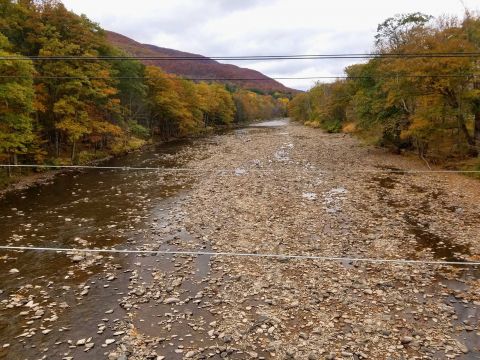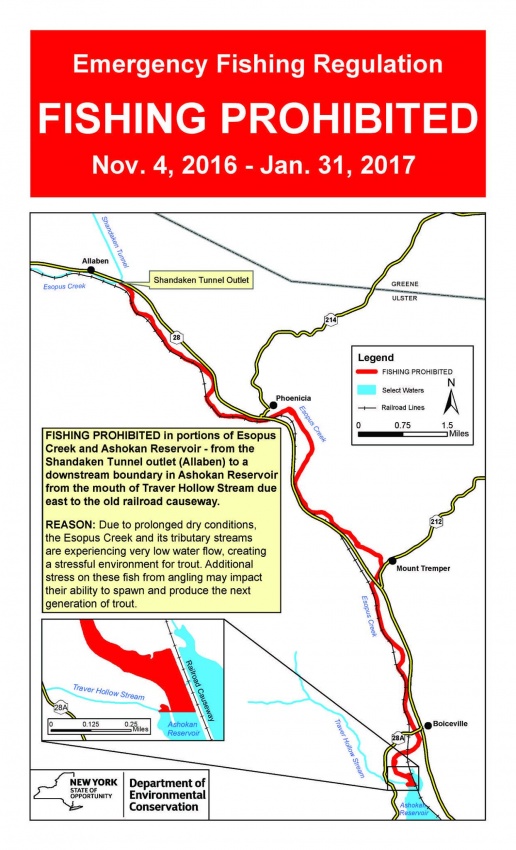
A view of the Esopus Creek from Five Arches Bridge on Route 28A in Boiceville, looking upstream. Photo by NYS Department of Environmental Conservation.
New York State environmental officials have issued an emergency ban on fishing in the upper Esopus Creek, citing prolonged drought that has left water levels in the creek alarmingly low.
Fishing is prohibited in an 11.9-mile stretch of the creek, from the outflow of the Shandaken Tunnel -- which carries water into the creek from New York City's Schoharie Reservoir -- to the Ashokan Reservoir. The ban is in effect until January 31, 2017.

The ban, issued on Friday, Nov. 4, comes at a critical time for the trout fishery. The trout fishing season on the Esopus does not end until Nov. 30 -- and brown trout, which are abundant in the Esopus, spawn in late fall. A DEC press release announcing the closure states that fish are already stressed because of the low water flow:
Due to prolonged dry conditions, the Esopus Creek and its tributary streams are experiencing low water flow, creating a stressful environment for trout. During these low-flow conditions, fish are more vulnerable to natural predators. Additional stress on these fish from fishing may impact their ability to spawn and produce the next generation of trout.
The move was celebrated by the local Ashokan-Pepacton chapter of Trout Unlimited, a fishing advocacy group that has been circulating a petition in support of the temporary fishing ban.
Chapter president Chet Karwatowski said that the ban was needed to ensure that next year's trout population is healthy.
"Streams throughout the Catskills are at the lowest point they've been in 20 years," he said. "The water is so low that the fish tend to congregate in certain areas, and become easier for people to catch."
Trout living in conditions as stressful as the ones now prevailing in the Esopus are unlikely to survive even if they are released after being caught, Karwatowski said.
Much of the Northeastern U.S. is currently in a state of drought, according to maps from the National Drought Mitigation Center. Water levels in New York City's Catskill-Delaware reservoirs are low: The city's water system, normally around 75 percent capacity this time of year, currently stands about 61 percent full. The Schoharie Reservoir, from which the city Department of Environmental Protection releases water into the Esopus Creek, is at only 12 percent capacity.
The Esopus Creek has been especially hard-hit by the drought, Karwatowski said.
"There are other streams that are open [to fishing], but they are also tailwater fisheries -- below the Pepacton, the Cannonsville, they still have water, they’re still releasing. It's less of a stressful situation there," he said. "There is no water in the Esopus. There’s no water in the Schoharie."
As climate change makes extreme weather conditions more and more common, local environmental agencies and nonprofits are increasingly concerned with how to react to things like droughts and storms, Karwatowski said. The increasing impact of climate change on natural systems in the Catskills was a central topic at a recent environmental science conference held at Belleayre.
"Everyone recognizes that what we're experiencing today is not an anomaly -- it may become more of the norm," he said. "There is a lot of discussion of what needs to change in the future. The good news is, that's being done collaboratively."













